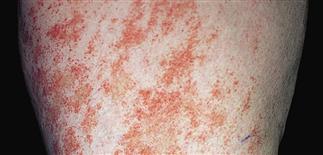90
Schamberg disease
(Schamberg purpura)

Distinct, orange-brown patches with numerous petechiae are referred to as cayenne pepper spots.

Irregularly shaped asymptomatic cayenne pepper spots commonly on the lower extremities.

Schamberg disease is a lymphocytic capillaritis resulting in petechiae and residual orange-brown pigmentation.

New petechiae are pin-point and bright red.
DESCRIPTION
A lymphocytic capillaritis resulting in progressive pigmented purpura, occurring most commonly on the lower extremities.
HISTORY
• Lesions slowly evolve on the distal lower extremities and progress proximally. • In adults, men are more commonly affected. In children, girls are more commonly affected. • The lymphocytic capillaritis suggests that this is a cell-mediated hypersensitivity. • Schamberg disease is a chronic condition without internal disease. • The vast majority of patients improve with time.
PHYSICAL FINDINGS
• Patients develop multiple, distinct, orange-brown, pinhead-sized ‘cayenne pepper’ macules with numerous petechiae. Lesions occur symmetrically on lower extremities and sometimes on upper body. New petechiae are bright red, becoming violaceous with age and leaving brown dots of hemosiderin pigmentation. • Schamberg disease can be asymmetric, especially when seen in adolescence. • May be a slight amount of erythema, scale, and itching.
TREATMENT
• Pigmentation can be covered with cosmetic creams such as Dermablend. • No consistently effective therapies, although the following have been administered: group V topical steroids, pentoxifylline (Trental) 300 mg q.d. for 8 weeks, rutoside (oral bioflavonoid) 50 mg b.i.d. and ascorbic acid 500 mg b.i.d. for 4 weeks.







